#(....like triggering the highest level trap in the starting room.. with my first action... was not COMPLETELY my fault)
Text
So I was dm for the first time the other day, playing a heavily modded up homebrew that basically threw all rules out the window so i could slowly introduce concepts to 2 new players.
i THOUGHT i had planned out enough to prepare.
i was wrong.
they were supposed to stop at the inn and maybe some shops, find some hidden stuff, go to the temple, and accept the mission, then journey into the overrun temple to actually, you know, have combat.
instead, 5+ hours and countless seat-of-pants additions i only partly prepped later, they’ve managed to injure each other instead of learning names, injure themselves, shoot an arrow down some sort of cursed well thingy, rescue trapped slaves from a room i never mapped out, dump fish on a burning inn before travelling back in time and melting the inn instead, then summoning a hurricane onto the town, farting on the blind monk healer i invented to save them from death, cause massive racism in not only the town but manage to personally insult the duke, and then on a whim before entering the dungeon, use the limited item of prayer to the gods to raze the entire city to the ground.
And at least one of those things i can’t even go into detail on because it LITERALLY HAS EFFECT ON AND SPOILS THE LAST BOSS
*cries in dm*
#i thought i was ready#i thought people were joking about how much players go off the rails#they found one (1) thing that i had planned on them finding#i didnt expect this#bc when i played i was a friggen goody two shoes who ASKED THE DM what i should do next#i only ever caused disasters by MISTAKE#(....like triggering the highest level trap in the starting room.. with my first action... was not COMPLETELY my fault)#PLUUUS#they missed SO. MANY. REFERENCES.#delicately handcrafted memes and inside jokes from their favorite things#WASTED#yes @lotrotter i am calling you out by name
12 notes
·
View notes
Text
My D&D 5e Build for Hordak

@firapolemos05 requested Hordak, I did some digging and thinking and came up with a build for this character. My judgement is based on what we’ve seen in the show and what I think suits his character best. Feel free to agree or disagree with this build or come up with one of your own.
Hordak, a member of a clone army that was rejected by his creator for having a defect in his cloning. He was sent on a suicide mission only to find himself taken through a portal and crash landing on Etheria. With the remains of a broken ship, he launched an Empire, taking over lands and territory and building his own army in the hopes of proving himself to Horde Prime. He serves as the main antagonist for most of the series before Horde Prime takes his place.
Long Post Below

***Stats***
Intelligence: Top stat. Hordak has a technological mind. He’s built machines, weapons, and portals and is one of the most intelligence characters in the series.
Strength: Second Highest. Reason being that we’ve seen him life heavy machinery in building the portal and throwing a slab of metal across the room. And he managed to push a huge beam off himself when it fell on him.
Constitution: Third Highest. I had thought of putting this lower on the list due to his chronic illness, but he did survive was having a crane fall on him and is managing to fight despite the illness.
Dexterity: Fourth Highest. Hordak can be quick when the needs aride.
Wisdom: Fifth Place. Hordak needed Double Trouble’s help to see through Catra’s lies about what happened to Entrapta.
Charisma: Dump state. Get. out! Hordak isn’t the most charming character in the series.

***Race***
I considered going with Variant Human again, but I just discovered the Gith- Githyanki race which I believe would suit Hordak better.
He automatically gets +1 to Intelligence and +2 to Strength.
Choose Arcana to be Proficiency skill. Hey, he must have taken time to study Etheria’s magic at one point and he has Entrapta helping him out.
Also, Hordak starts off knowing the Mage Hand cantrip.
Choose the Soldier background: This nets Hordak a Proficiency in Athletics and Intimidation.

Okay, after some thought and consideration, I’ve decided to start Hordak off as a Barbarian.
The reason for this when Hordak get’s angry, he can become quite dangerous and resilient to damage.
***Barbarian Level 1***
Hordak gets the Rage ability:
- advantage on Strength checks and Strength saving throws.
- A melee weapon attack using Strength, gains a bonus to the damage roll
- resistance to bludgeoning, piercing, and slashing damage.
Unarmored Defense - armor class equals 10 + Dexterity + Constitution. His suit is more of an exo-skeleton for his health condition. And his dress is a bit revealing.
For Skills choose Perception and Survival. The first few years after crashing on Etheria must have been rough at the start.
***Barbarian Level 2***
Hordak receives Danger Sense : Has advantage on Dex saves against effects he can see such as traps and spells. He’s been fighting magical princesses for years, however he can’t use this ability if he is blinded, incapacitated, or deafened.
Reckless Attack: For the first attack on his turn, he can choose to attack with advantage with melee weapons using Strength, but attack rolls against him will be at an advantage until his next turn.

***Barbarian Level 3***
Barbarians can choose a Primal Path. For Hordak, reveres Horde Prime and conquers Etheria in his name, the Primal Path for him would be Path of the Zealot.
Divine Fury: when Raging the first creature Hordak hits on each of his turns with a weapon takes extra damage equal to 1d6 + half Barbarian level. Choose Necrotic damage he is fighting in the name of an evil cult leader.
Warrior of the Gods: Hordak is easier to raise from the dead. If any spell cast to restore life to Hordak doesn’t need any components. That’s the advantage of a having a devoted hi-tech wife.
***Barbarian Level 4***
Ability Score Improvement: Put the points into Intelligence to max it out. I know Strength is important for a Barbarian class, but there is a method to my madness.
***Barbarian Level 5***
Extra Attack: Hordak can make two attacks when he takes the attack action.
Fast Movement: His speed increases by +10 feet when he isn’t wearing heavy armor.

***Barbarian Level 6***
Path of the Zealots gives Hordak Fanatical Focus which allows to reroll a failed saving throw while Raging, but must take the new roll. Ability can only be used once per Rage.
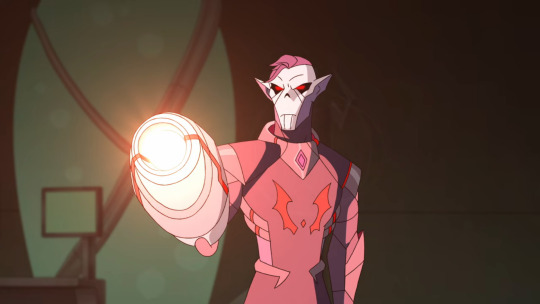
Now you’ll see the method in my madness with a high intelligence score.
We’re going into Artificier, a class the melds magic and technology, which he learned from Entrapta and from studying Etherian magic and First Ones Tech.
***Artificer Level 1***
Talk to your DM about the Optional Firearm Proficiency. If they agree, then Hordak has a proficiency in firearms, such as laser cannons!
Being an Artificer gives Hordak Magical Tinkering: Hordak’s Tinker Tools come into play which allows him to create a spark of magic in a Tiny nonmagical object with a magic effect such as giving off light, playing a recorded message (Like the Imp), etc.
Hordak is able to use his Intelligence to create magical effects in objects through spellcasting, but use his tools to do so. So choose plenty of offensive spells for Hordak to use against Princesses. I would recommend for cantrips:
Acid Splash: You hurl a bubble of acid. Choose one creature within range, or choose two creatures within range that are within 5 feet of each other. A target must succeed on a Dexterity saving throw or take 1d6 acid damage.
Fire Bolt: You hurl a mote of fire at a creature or object within range. Make a ranged spell attack against the target. On a hit, the target takes 1d10 fire damage. A flammable object hit by this spell ignites if it isn’t being worn or carried.
For 1st level spells:
Absorb Elements: The spell captures some of the incoming energy, lessening its effect on you and storing it for your next melee attack. You have resistance to the triggering damage type until the start of your next turn. Also, the first time you hit with a melee attack on your next turn, the target takes an extra 1d6 damage of the triggering type, and the spell ends. (Good for when he goes into melee against elemental Princesses).
***Artificer Level 2***
Infuse Item: Hordak can Imbue mundane items with magical infusions. At this level you can choose up to 4 infusions to know, but can replace one of them at each level.
Choose:
Enhanced Defense: Needs a suiit of armor or shield to grant a +1 bonus to Armor Class while wearing (armor) or wielding (shield) the infused item.
Enhanced Weapon: Needs a simple or martial weapon to grant +1 bonus to attack and damage rolls made with it.
Enhanced Arcane Focus: Needs rod, wand, or staff (requires attuning) a creature gains +1 bonus to spell attack rolls.
Replicate Magic Item : Any item of your choice to replicate.
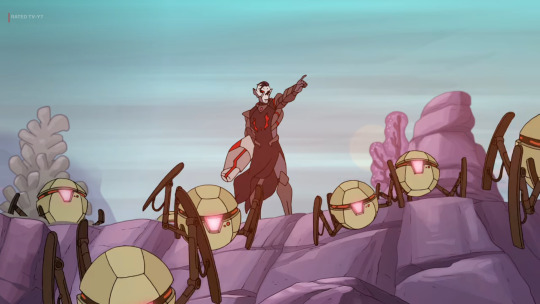
***Artificer Level 3***
The Right Tool for the Job : with tinker's tools in hand, Hordak can magically create one set of artisan's tools when needed.
Now Hordak can receive an Artificer Specialist. Take Artillerist.
Tool Proficiency: Gain proficiency with Wood Carver tools, but to better fit Hordak’s character, I would go with Smith’s Tools if the DM allows it.
Hordak gains 2 additional spells.
Shield: An invisible barrier of magical force appears and protects you. Until the start of your next turn, you have a +5 bonus to AC
Thunderwave: A wave of thunderous force sweeps out from you. Each creature in a 15-foot cube originating from you must make a Constitution saving throw. On a failed save, a creature takes 2d8 thunder damage and is pushed 10 feet away from you. On a successful save, the creature takes half as much damage and isn’t pushed.
The golden part of this level is Eldritch Cannon. Hordak can create small or tiny canons. Think Horde Robots. They can have one of three effects: Flame Thrower, Force Ballista, and Protector.
***Artificer Level 4***
Ability Score Improvement: Max out Intelligence to attain more spells and make them more powerful. If Intelligence is already maxed out, you can put them into Strength so Hordak can hit harder when in melee or you can round out the other ability scores.
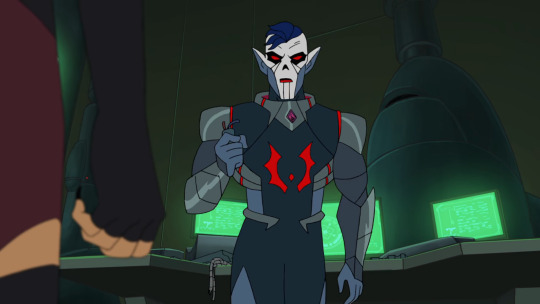
***Artificer Level 5***
Arcane Firearm: Hordak can turn a rod, wand, or staff into an Arcane Firearm (such as an Arm Cannon) to case offensive spells. Doing so gives a 1d8 bonus damage to spells. If the spell hits multiple targets, choose one to take the bonus damage.
Hordak can now use 2nd level Artificer spells. I recommend:
Heat Metal : Hordak can cause a metal object (armor for example) to glow red-hot. Any creature in physical contact with the object takes 2d8 fire damage when you cast the spell. Until the spell ends, you can use a bonus action on each of your subsequent turns to cause this damage again.
Also Artillerist gains two additional spells.
Scorching Ray: You create three rays of fire and hurl them at targets within range. You can hurl them at one target or several. Make a ranged spell attack for each ray. On a hit, the target takes 2d6 fire damage.
Shatter : A sudden loud ringing noise, painfully intense, erupts from a point of your choice within range. Each creature in a 10-foot-radius sphere centered on that point must make a Constitution saving throw. A creature takes 3d8 thunder damage on a failed save, or half as much damage on a successful one. A creature made of inorganic material such as stone, crystal, or metal has disadvantage on this saving throw.
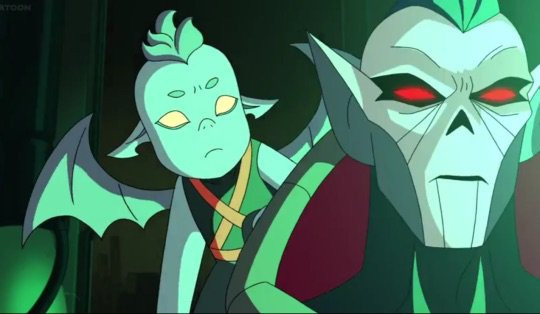
***Artificer Level 6***
Tool Expertise: proficiency bonus is doubled for any ability check you make that uses your proficiency with a tool.
Also, Hordak gains two additional Infusions.
Pick Homunculus Servant so Hordak can create his own Imp, a tiny construct that obeys commands.
Repulsion Shield : grants a +1 bonus to AC when using this shield. Also has 5 charges to push an attacker back 15 feet as a reaction to being hit by melee weapon.
***Artificer Level 7***
Flash of Genius: As a reaction, Hordak can add his intelligence modifier to an ability check or saving throw of a ceature within 30 feet of him.
***Artificer Level 8***
Ability Score Improvement: By now Intelligence should be maxed. Put points into Strength if you are having Hordak wade into melee battle. And/Or, you could get the War Caster feat which will make it easier for Hordak to cast and maintain spells in battle.

***Artificer Level 9***
Explosive Cannon: Eldritch Cannons now cause more damage with additional 1d8 damage and Hordak can have them self-detonate for 3d8 force damage on a failed Dex save.
Hordak can now use 3rd level spells.
Dispel Magic: Choose any creature, object, or magical effect within range. Any spell of 3rd level or lower on the target ends. For each spell of 4th level or higher on the target, make an ability check using your spellcasting ability. The DC equals 10 + the spell’s level. On a successful check, the spell ends. (Hordak must have been studying a means to remove magical effects, plus this spell is super useful).
Plus being an Artillerist grants two additional spells.
Fireball: A bright streak flashes from your pointing finger to a point you choose within range then blossoms with a low roar into an explosion of flame. Each creature in a 20-foot radius must make a Dexterity saving throw. A target takes 8d6 fire damage on a failed save, or half as much damage on a successful one. The fire spreads around corners. It ignites flammable objects in the area that aren’t being worn or carried.
Wind Wall: A wall of strong wind rises from the ground at a point you choose within range. When the wall appears, each creature within its area must make a Strength saving throw. A creature takes 3d8 bludgeoning damage on a failed save, or half as much damage on a successful one.

***Artificer Level 10***
With Entrapta’s help, Hordak can become a Magic Item Adept: he can attune up to four items at once instead of just two. And it takes a quarter of the time to craft a common or uncommon magical item and doing so costs half the gold.
And Hordak can learn two more Infusions.
Spell-Refueling Ring (Unearthed Arcana) - A ring that can recover expended spell slots. (Hordak can keep throwing spells back at Princesses)
Mind Sharpener (Unearthed Arcana) - Robes (or armor) that can allow the wearer to maintain a spell as a reaction if they failed a constitution check.
***Artificer Level 11***
Spell-Storing Item: Hordak can store a 1st or 2nd level spell inside an item for a creature to use
***Artificer Level 12***
Ability Score Improvement: Intelligence should be maxed. Strength should be maxed. Also round out any Ability Scores. Or you can get the War Caster feat.
***Artificer Level 13***
4th level spells are now available. I recommend:
Arcane Eye: You create an invisible, magical eye within range that hovers in the air for the duration. You mentally receive visual information from the eye, which has normal vision and darkvision out to 30 feet. The eye can look in every direction.
***Artificer Level 14***
With the help of his beloved Entratpa, Hordak becomes a Magic Item Savant. He can attune up to five items with magic and he can ignore all class, race, spell and level requirements to use any magical items.
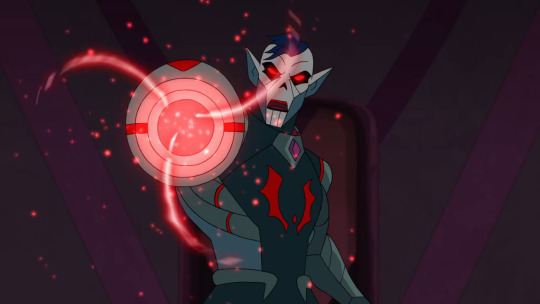
And there you have it. My version of Hordak in D&D 5e. With the Barbarian levels he can deal decent melee damage and withstand receiving damage and gaining extra strength while Raging.
As part of his background and his close relationship to Entrapta, he can infused magic into items and use offensive spells against the Princesses in his conquest of Etheria.
55 notes
·
View notes
Text
Session #1
My friends and I have begun to play 5e D&D (many of us for the first time!) and I just wanted to have a place where we could refer back to what has happened/relive some of the memories sometime in the future so I’m cataloging our sessions here 🤙
An introduction to our characters / the players (or at least their first initials) who play them:
M - Aerin, the Vedalken artificer who’s reluctantly enthusiastic about his surroundings.
H - Joe Mama, the Goblin druid who’s currently trying to start a religion in which he’s the God. He also has one of the highest ACs in our party and very rarely gets hit.
G - Adelia Selphindale, the Half-Elven Bard who’s hasn’t had any actual bard training per-say but is currently traveling with our merry band of misfits in the attempt to acquire some.
C - Marzen (Marz for short) Beck, the Half-Elven ranger who was orphaned as a young lad and has struggled to live off of the land ever since. He doesn’t enjoy killing all that much (like to the point where he feels bad when fishing/hunting) but will protect himself if the need arises.
P - Mallory Nowhere, the Tiefling sorceress who had to flee from home a year before our campaign started as the awakening of her powers caused the loss of a handful of lives.
E - Our generous DM.
A description of our first session:
Our story begins with our ‘heroes’ falling into a pit of undiscernable height and being seemingly and miraculously unharmed.
Once they have gotten their bearings, the party takes a look around the room they’ve found themselves in and notice another traveler who’d fallen into the pit some time before them.
Here’s the kicker: he’s trapped underneath the wagon he had been traveling in.
After some debate about whether or not they should trust him, after all he could've been working for those that had trapped them as a decoy or something, they lift the wagon off of him and the poor guy begins to tell them his story.
It turns out that he had been traveling with some friends and family but they’d been dragged off by some inconspicuous figures just before lady luck momentarily averted her gaze and we suffered the same fate his group had.
Mumbling is heard from outside of the door, though at a distance, and the panic begins to set in.
Mallory suggests that one person should stand in front of the door as a distraction while Joe (the shortest, and likely, least heavy party member) gets up on the shoulders of Aerin (our tallest member) and then hop off onto the first person that walks into the door.
Soon after getting into position, the door bursts open and three of our captors barge in.
Joe leaps into actions but misses.
Mallory, standing in front of the door and next to Adelia, casts sleep and sends the three of them straight to, well, sleep.
Once their weapons had been confiscated the group of them moves out into the hallway from which their foes had come.
In the hallway was a chest (which had some minor potions of healing) and one other door.
The party goes through.
On the other side of the door were a bunch of people who could only be described as cultists spread out across the room, their leader in the center performing some kind of ritual on an altar, and a cage full of undead to the party’s right.
Their leader notices them enter and warmly invites them to join in on their... escapades.
The group, save for Mallory who was curious until he offered to turn her into a zombie, declines.
Adelia asks if they can leave but, unfortunately, fails her persuasion check.
The leader gestures towards the exit and the party blissfully follows his guidance.
BAM! A trap door is triggered just in front of the exit opening the floor beneath them and revealing a hole full of spikes.
Aerin, Joe, and Mallory manage to jump out of the way in the nick of time.
Adelia wasn’t so lucky. (In the end, she was fine though as Aerin used some of his rope to pull her out)
Cue combat!
Some highlights from the combat
The combat lasted for well over 2 hours as:
We were first levels
Our DM didn’t expect us to have the gall to actually take on all of these guys, let alone win.
Joe Mama spent a lot of time scurrying around the place stabbing, looting, and very rarely getting hit.
Mallory pushed the cult leader, who we were told after the fact that he could’ve killed us in one hit if we gave him a chance, into his pit effectively rendering him useless (and dead. You can’t forget dead)
The dice gods were just not in Adelia's favor as she got bitten, scratched, and everything in between for a lot of it.
She also had one of the highest kill counts to make up for it.
Aerin was a lean, mean, neck-snapping machine for a lot of the combat.
Conclusion of Session 1
Mallory finds a treasure map in the Cult Leaders office.
The gentlemen who was trapped underneath the wagon came and joined us after leaving his hiding spot.
The poor dude was horrified to notice that all of the undead we just slaughtered were what remained of the people he’d been traveling with.
After saying their condolences, the party began to make their way towards the exit.
This concludes our first session
2 notes
·
View notes
Text
Where it all started...
I cannot start this journey without talking about the first character I ever made, the one I am still currently playing: Kara, the Human Rogue.
So, let’s start by saying that I love my DM cause the first thing I said to her was “I want my character to be a Weretiger and for her to stay like that for a long time” and she actually said yes. Which is why the most important thing to know about this PC is that some homebrew rules were used. [Also, we play in a revised version of the Forgotten Realms, cause our DM used to only play 3.5 and it was her first time DMing 5e.] That being said, we can dive into the details!
Human (Weretiger) Rogue (Inquisitive Archetype)
with a revised Outlander background

Noteworthy Proficiencies
-Saving Throws: Dexterity, Intelligence;
-Skills: Sleight of Hand, Survival (from the revised background), Insight, Investigation, Perception, Stealth (with Expertise on Stealth checks and Thieves' tools);
-Tools: Disguise kit (from the revised background), Thieves' tools;
Noteworthy Random Features
-Shapechanger: bonus action to polymorph into a Medium Tiger-Humanoid hybrid or into a Medium Tiger. Gain Claw (1d6 slashing) and Bite attacks (1d8 piercing, must succeed a Constitution saving throw DC 12 or be cursed with weretiger licanthropy). [Can NOT multi attack Bite/Claw, but the DM allowed double Claw attack as Action+Bonus action combo in a “two-weapon fighting” like attack.]
-Resistance: when in Hybrid or Tiger form gain resistance to Bludgeoning, Piercing and Slashing damage from nonmagical weapons that aren’t silvered. Also gain a +2 to AC.
-Keen Smell: gain advantage on Perception checks that rely on smell while in Hybrid or Tiger form.

Something about her backstory
Kara had a pretty quiet childhood, the only two highlights were her two younger twin brothers being born and meeting a cleric of Oghma that told her she could use her brain to do anything she wanted. It was when she was about 15 years old that an older guy she never saw in her village started approaching her; since anyone really paid her those kind of attentions, she fell for his ruse and followed him into the woods, without knowing her meddling brothers were following them. It all obviously went south pretty quickly and she ended up captured and bitten, soon to be mated with another were, while her brothers were literally eaten alive in front of her by the kidnapper. When she finally managed to free herself during a full moon, she was consumed by guilt for what happened to her brothers and scared she could hurt the people she still loved at her village. So she ran away and never turned back, living of pickpocketing on the outskirts of random cities and finding refuge in the wilderness during full moons. Her dream was to get rid of the curse and use everything she learned to become some kind of detective, so she could help people in need rather than steal from them.
Ability Scores
(I can’t remember what were the increases we landed on after long discussion between me and the DM, since it’s been so long; I think it was +2 Dexterity and +1 Intelligence, instead of the usual +1 to every score of the normal human.)
I already knew when I started playing her that I wanted to push for a “jack of all trades” kinda girl: it’s not that she wants to do everything on her own, she had to be independent because of her past. I wanted her to be tough too, maybe a little bit rough at the edges after ten years of mostly solitude in the wilderness or as an outcast in the outskirts of random cities.
Which is why, at end of the day, her highest score is obviously Dexterity, followed by Constitution and Intelligence. It just made sense for a rogue weretiger to be quick on her feet and apt to hiding in the dark. Constitution is mostly related to the kind of life she lived and, once again, being a were gives you a thick skin in more than one sense. Intelligence is more related to her teenage years, before the curse; but she’s also curious, she wants to learn new things and find mysteries to solve. She does have a problem with magic tho: can’t really stand it, nor understand most of it.
Wisdom and Strength are just average, but I decided that it would be perfect to place the only score that would grant me a negative modifier in Charisma. That doesn’t mean she’s a quiet girl, tho. She has no idea how to flirt with people or how to take a compliment, and there is probably gonna be at least a curse in every sentence that gets out of her mouth. But when it comes to money nothing can stop her from trying to negotiate to get what she thinks her party deserves for a job well done. She might make some questionable decisions too sometimes, but those rash actions usually end up helping her, so...
A quick look into the gameplay/roleplay
Like I said, I really planned for Kara to be a little bit all over the place. She had a plan for what she wanted in life, but she also thought she would never work with anyone. Then the party happened and she immediately felt responsible for everyone in it, especially for the youngest member, which is the newly orphan 15 years old boy fighter, and the bard, which had basically never seen anyone die before they all started traveling together.
Which is why I quickly realized I was not gonna play a straight up rogue for long; pretty much after two sessions I already knew Kara would want to be stronger for the party, which is why as soon as she reaches level 5 she’s gonna take the first of three levels of fighter (and I already chose the dual wielder feat when she reached level 4, and I plan to pick two-weapon fighting as her fighting style and Champion as her martial archetype, before going back to rogues’ levels).
As for the roleplaying side, like I said, she’s mostly easy going, loud and lewd, but at the same time she can be shy and insecure. She likes to let others think she doesn’t give a crap about anything, but it’s pretty easy to see she cares quickly about other people, even if you gotta earn her trust first. She still follows some of Waukeen’s church dogmas, cause she actually believes in them and feels like they’ll bring her to something good in life sooner or later.

And that’s it. If she probably seems a bit OP with all the things she can do and stuff, it’s because she probably is. BUT, hear me out: my luck has been shit with basically every roll I had to make up till now. She has been paralyzed two times and both times I could not for the life of me get her to save from it before the end of the battle! One time she almost got eaten by a monster, another she almost ended up dying in the middle of the fight cause I could not save against poison, she triggered all of the traps in a dungeons’ room just by throwing ONE ball bearing wrong... For real, the universe knows how to balance things out: she has dealt a lot of damage, but she’s the one with less kills of the party; she’s the most useful during investigations, but always ends up hurt because of that. Kara is not lucky, nor am I planning to take the lucky feat to fix that problem. It’s just not how life works for her, and I’m actually okay with it, even if I just complained about what I think is her actual curse!
#dnd#d&d 5e#dungeons and dragons#dnd character#character idea#character inspiration#homebrew content#rogue#human#weretiger#outlander#high dex#low cha#inquisitive#TheTroveRoster#TheTrove
2 notes
·
View notes
Text
Venus Flytraps Have Magnetic Fields Like the Human Brain
Much of my childhood was spent deep in dialogue with a crew of non-sentient play pals. The top dogs in my pack of fixations were 1) magnets and 2) Venus flytraps. Proximity to either dialed in many an afternoon fugue state. Lounging now, in the temperate solarium of mid-adulthood, I find myself peering back through time’s foliage and wondering: why??
Sure, these earthly offerings exceeded the expectations of your garden-variety rock or plant. But both seemed to contain a potential far beyond their already-otherworldly capabilities. A magnet could be amplified to say, unhand an assailant of a weapon. If cultivated aggressively a Venus flytrap might consume far larger prey. For child me, these entities possessed dormant superpowers just waiting to be awoken.
And then I awoke this morning to find that for the first time in history, a group of mavericks out of Switzerland have detected a magnetic signal in a plant. Using a highly sensitive magnetometer, an interdisciplinary team of researchers have measured signals from a Venus flytrap of up to .5 picotesla. To make matters even more mind-blowing, this signal is roughly equivalent to the biomagnetic field strength of the human brain. The full report is here.
The findings shine a light on a whole new world of plant communications we never knew was there and paves the path for new approaches to diagnose and treat plant diseases. It’s a parade-worthy "I told you so" for champions of plant intelligence, and a new dawn for how we live in harmony with the green kingdom.
With that, kick back, throw on Plantasia and let's get into the electromagnetic weeds!

Image: Johnny Ryan
It all starts with biomagnetic signals
So, why does it matter that a plant has a detectable biomagnetic signal? Well, bioelectromagnetism is the amount of magnetic signal given off by a living thing, and it’s what the Swiss research team just measured. Biomagnetic signals originate from electrical fields generated by the physiological activity of a specific organ or tissue, such as the human brain.
The electrical field is driven by "Action Potentials," which is the difference between the resting and highest electric impulse of an entity in a given period of time. To give you an idea of what that looks like, where the line spikes at +30mV here, that’s the impulse of a human brain neuron. So the Action Potential here is 100mV:
Credit: Eric H. Chudler, Ph.D., University of Washington
One or many Action Potentials then contribute to a magnetic field.
So, for instance: A muscle contracts —> An electrical impulse is emitted —> An Action Potential hits —> An Electrical Field is generated —> A Magnetic Field is generated —> Both party together right on down the electromagnetic line.

Image: Thobey Campion
Lots of things besides brains and plants give off magnetic fields. Here’s a comparative chart.
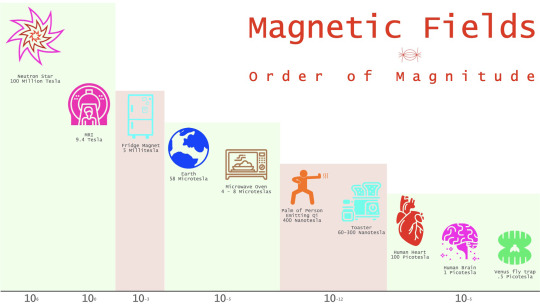
Image: Thobey Campion
Some perspective on scale:
• A toaster’s magnetic field is 300,000 times more powerful than the human brain’s field
• The Earth’s magnetic field is 2,000 times more powerful than a toaster’s field
• And a fridge magnet is 58 times more powerful than the Earth’s field
That makes the signal we just detected from a Venus flytrap almost exactly a billion times weaker than a fridge magnet, and explains why plant signals have flown under our radar for so long.
In the 1960s, though, a new class of magnetic field sensor showed up on the scene. It could detect weak biomagnetic fields, from a human brain and potentially even a plant. Behold…
The Superconducting Quantum Interference Device (SQUID)
SQUIDs are sensitive magnetometers used to measure extremely subtle fluxes in the magnetic field. The magneto-sensitivity of SQUIDs gives them extraordinary powers for recognizing the world around us. They represent the closest our technology has come to being psychic.
The hero feature of a SQUID is the Josephson junction. It's composed of two superconductors separated by a super-thin insulating material, usually copper.
The device gets inserted into a -346 Fahrenheit bath (usually nitrogen or helium). This cools the SQUID down to superconducting temperatures. The bath sits in a lead container, both of which also shield the SQUID from other magnetic fields which, in their ubiquity, are a real nuisance for detecting subtle magnetic field changes.
Any electrons passing through the junction demonstrate quantum interference, which then gets run through an algorithm and spits out a magnetic field reading.

Image: Thobey Campion
The list of applications for SQUIDs in defense, geophysics, space exploration and beyond is currently exploding with possibilities even decades after the device first showed up on the scene.
To give a sense of the power of the SQUID: mining company Outer-Rim Developments in Australia used a SQUID to measure ground surface electrical connectivity, successfully identifying a silver deposit two kilometers below the Earth’s crust. It’s the largest found anywhere ever, worth about $2 billion.
In 2017, researchers at the Shanghai Institute of Microsystem and Information Technology also developed a SQUID array that can detect a submarine magnetic field from an outlandish six kilometers away. It can also effectively time travel, identifying a submarine’s magnetized particle "wake" as much as two weeks after the fact.
And now, SQUIDs have initiated a potential quantum shift in our relationship with plants.

Image: Anne Fabricant
The experiment
The Venus flytrap boasts three trigger hairs that serve as mechanosensors. When a prey insect touches a trigger hair, an Action Potential is generated and travels along both trap lobes. If a second touch-induced Action Potential is fired within 30 seconds, the energy stored in the open trap is released and the capture organ closes. This is the plant-insect equivalent of a repeat offender. Imprisonment ensues.
Crucial to making these findings was the fact that this electrical activity doesn’t carry into the stalk of traps, which allowed the researchers to isolate the lobe by slicing it from the rest of the plant. Biologically intact, it was then placed on to a sensor.
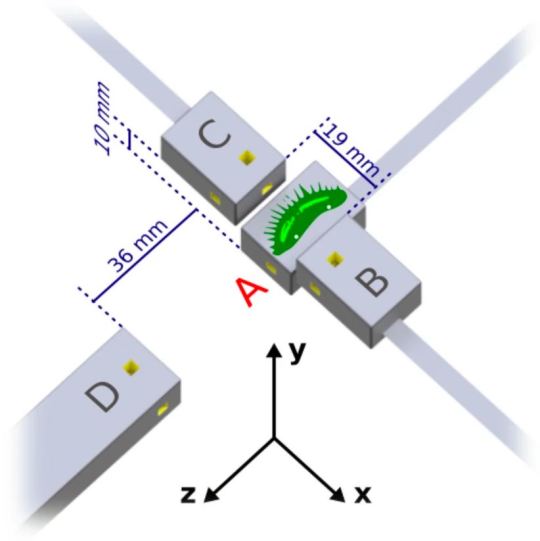
The size and biology of a plant cell pose all sorts of regional challenges for magnetic field sensing. To tackle the challenge the researchers needed:
• A diverse team from Johannes Gutenberg University Mainz (JGU), the Helmholtz Institute Mainz (HIM), the Biocenter of Julius-Maximilians-Universität of Würzburg (JMU), and the Physikalisch-Technische Bundesanstalt (PTB) in Berlin, Germany's national meteorology institute.
• Heat stimulation to trigger Action Potentials in the fly trap because thermal energy emits zero background noise.
• A custom sensor consisting of a vapor-filled glass cell that further suppressed noise.
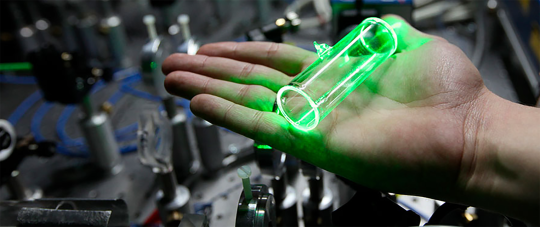
Image: UW/Mateusz Mzelanik
• Additional sensors placed around the room to differentiate any plant signals from environmental noise.
• An optically pumped magnetometer, as opposed to cryogenic cooling, which can be miniaturized and also prevented the plant matter from freezing.
The readings returned pretty much identical results four times in a row.

The discovery is as huge for biomagnetism in plants as it is for electro-physiology in general. We now have proof of a pathway for long-distance signal propagation between plant cells. Talk amongst your cells.
Both signal a new era of understanding plant systems we are only just coming to grips with.

A 2017 study published in 'Frontiers in Plant Science' looked at the photosynthetic properties of pale green leaf rice. Image: Gu, et. al.
Now what?
The report’s introduction ponders, “in the future, magnetometry may be used to study long-distance electrical signaling in a variety of plant species, and to develop noninvasive diagnostics of plant stress and disease.”
With the help of this current research, crops could be scanned for temperature shifts, chemical changes, or pests without having to damage the plants themselves.
But that’s tomorrow, and we are unfortunately fastened firmly to today.

Image: Motherboard
To get a sense of the bigger picture, I spoke with Greg Crutsinger, Director of Applied Research at GeoAcuity. Motherboard highlighted his work in turning consumer drones into high-precision crop monitoring tools a few years ago. His efforts allow farmers to rapidly and repeatedly monitor the health of their plants from the sky, identifying which areas of land need more water or fertilizer.
Our conversation exhibited a common refrain. Before widespread application of this new sensory technology, our species needs to first open our minds to a hidden electromagnetic network.
“We’re so biased by human eyes," Crutsinger said. "Yesterday I was going through some of the microsatellites that are going to scan the Earth with radar. We’re looking at different wavelengths and how they can measure moisture in plants by how deep the radar penetrates into corn. I look at the world in different spectrums now and different scales. This is similar. It’s just at this fine scale we haven’t thought of yet.”
Beyond the perceptual, there are daunting practical considerations. Lab settings provide a convenient vacuum where these almost-imperceptible magnetic fields can be measured without getting drowned out. Greg was clear about the challenges of packing up this gear and heading out into the world.
“Typically what we’re thinking about when we’re in plant magnetic spectrums is imagery and light: how are they interacting with wavelengths beyond the scope of the human eye? We can pretty easily use different sensors for that," he explained. "The challenge is mechanical, trying to measure it, and understanding what it means at such a fine level.”
Obstacles aside, new advances contain huge promise for understanding the staggering amount of data we’ve been looking past.
“I have a drone that I just picked up from Best Buy and did a 3D model with over lunch. The potential is moving very quickly to miniaturize a lot of these capabilities,” said Crutsinger. “As we advance the sensitivity of these tools and more people start using them and not just two labs in the world, I think they’ll start becoming more commonplace in terms of adoption.”
Perhaps our best next step is looking at how other species interact with these magnetic fields. Since these fields exist, they may serve some practical purpose. “Plants and insects have co-evolved for millions of years,” explained Crutsinger. “The trap is getting prey. But insects could leverage that to their own benefit as well. They’re super sensitive and they have antennas. How might they cue in on the magnetic fields of the plant. It’s just also something we have to pay attention to.”
It’s at once discouraging and hopeful to consider the vastness of what we can’t perceive. Perhaps human consciousness is not so much defined by knowing that we know but by acknowledging what we do not.
Either way, it’s a heck of a day for plant nerds.
Thobey Campion is the former Publisher of Motherboard. You can subscribe to his Substack here.
Venus Flytraps Have Magnetic Fields Like the Human Brain syndicated from https://triviaqaweb.wordpress.com/feed/
0 notes